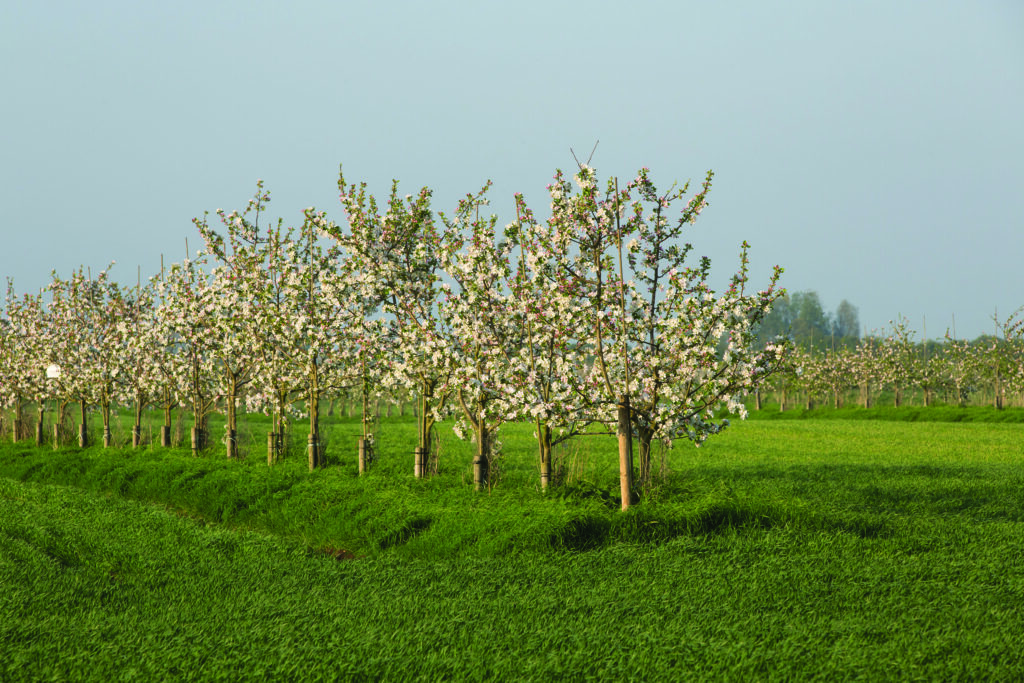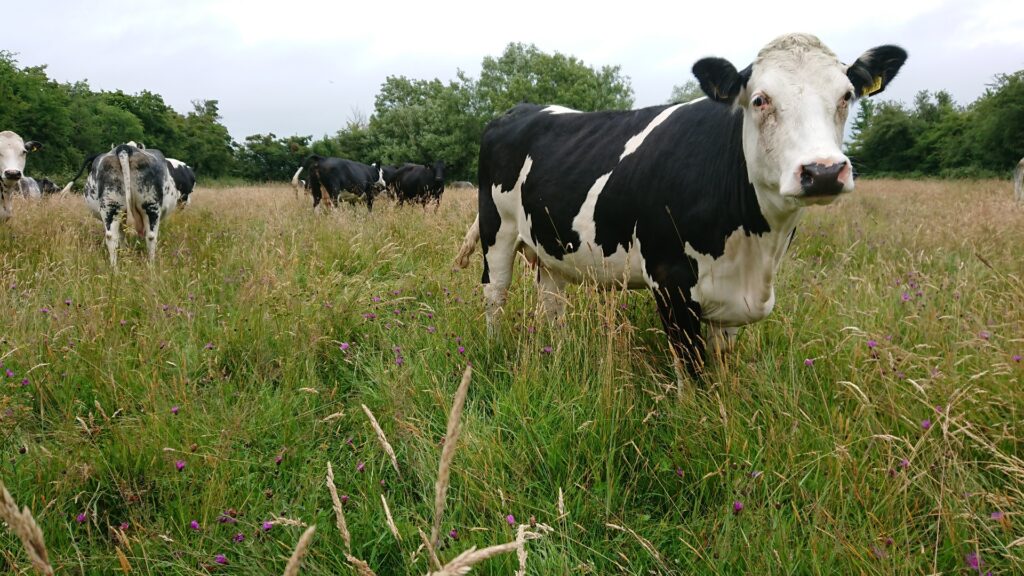
Regenerative agriculture has experienced a sharp rise from a niche concept to a commonplace strategy across the UK agricultural sector. It holds promise as a win-win strategy to address net zero and long-term farm productivity.
Centred around improving and revitalising soil health, regenerative agriculture can be defined as any form of farming, which at the same time benefits the environment.
Regenerative agriculture’s loose definition offers farms the freedom to interpret it as most appropriate to their system, encouraging widespread uptake across a diverse range of farm businesses. The rapid growth of Groundswell, the UK’s annual festival of regenerative farming, illustrates the momentum behind this movement.
The prospect of cutting inputs and costs, against a backdrop of volatility in feed, fuel and fertiliser markets, is appealing to most farms. When also considering the need for businesses to adapt to the restructuring of the farming subsidies and to reverse declining soil carbon stocks, it is clear to see the major role regenerative agriculture could play for years to come.
It is shaped by a set of five core principles which cover a range of holistic land management practices. By embracing the following principles farms can begin to regenerate their soils:
- Minimise soil disturbance
A large proportion of regenerative agriculture focuses on the key principle underpinning a healthy ecosystem, the soil. Soil is the foundation of the ecosystem and without it, plants cannot grow, and animals cannot be sustained. Minimising soil disturbance, and ultimately soil degradation, can be achieved through reduced tillage agriculture, which lessens the amount of carbon released from the disturbed soil, and allows for the regeneration of organic matter below the topsoil. The connectivity of the agroecosystem is affected by soil disturbance and tillage. Consistent soil disturbance affects water infiltration as well as the movement of gases, nutrients and water within the soil and roots through soil pore networks. Soils with poor structure limit the interaction between organisms within the soil and fungal networks, all contributing to healthy functioning soils[1]. Under regenerative models, as soils increase in fertility their water holding capacity also increases, thereby increasing the natural, biological productivity of the land and encouraging species growth. Allowing for the soil to regenerate, with minimal disturbance from conventional cultivations, facilitates the organic matter in the soil to contribute towards the growth of crops on the surface. This enables a reduced reliance on artificial fertilisers to improve the fertility of the soil and leads to an overall improvement in the condition of the land. 1
2) Maximise crop biodiversity
Establishing and maintaining as much plant diversity as possible creates a good environment within the soil for maximisation of the microbial population. In the absence of diversity, through continuous cultivation of the same crop species, imbalance develops within the soil leading to reliance on artificial fertilisers to provide specific nutrients. This leads to reduced soil organic matter, degradation of soil structure and soil biology. A greater diversity in crops creates greater root depth diversity within the soil, allowing for more organic matter to be left in the soil once these plants die off. Companion cropping and intercropping, as well as diverse main crop rotations, are methods to increase diversity within an arable crop during rotations, delivering benefits including pest reduction, weed suppression and increased nutrient accessibility and uptake of nitrogen and phosphate. As a result, improvements in crop yield and crop resilience will lead to long term benefits to overall soil health and less reliance on artificial fertilisers1.

3) Keep the soil covered
There are a number of benefits to covering the soils with cover crops, cash crops or with a mulch of crop residue. These practices protect the soils beneath to a variety of threats; wind and water erosion, compaction and weed growth whilst maintaining evaporation rates and soil temperatures. Exposed soil is at risk from water and wind erosion, therefore keeping it covered all year round minimises the risk of damaging the soil. The estimated annual costs of soil degradation in England and Wales total between £0.9–1.4 billion[2].
Cover cropping can be both short-term and long-term options for the soil, acting as a shield and covering the soil surface. The extended period of growing is also often described as ‘solar powered soil building’ due to the physical, chemical and biological benefits derived from the crop capitalising on the sun’s energy through photosynthesis. Short-term cover crop mixes include faster growing species, such as radish, mustard, buckwheat and linseed. Over-winter mixes are longer term options which include winter rye, spring oats and stubble turnips as some examples. Mulching can be achieved with natural or synthetic materials but natural materials on farm are most common. Leaves, plant residues, grass clippings, hay and straw are examples of mulch, acting as a source of carbon and nitrogen as they breakdown on the surface[3].
4) Maintain living roots year-round
The presence of plants and active roots within the soil is key to optimal soil health and structure, as they provide the energy for the biological processes within the soil. The absence of plants causes carbon to be released, as carbon dioxide, via respiration due to the soil biota metabolising the soil organic matter. This would have otherwise been used as energy for the root and plant growth. Plant and soil biology share a close relationship, centred around plant roots where a host of organic substances are excreted by the plants. Mycorrhizae are a particular type of fungi connecting plant roots, growing in smaller soil pores enabling them to acquire and pass on nutrients, particularly phosphorus, at a quicker diffusion rate through the soil. Considering integrating cover crops directly after harvest is one way to ensure active roots are kept within the soils. This is when the soils would otherwise be left bare for over four weeks and as a result beneficial microbial populations start to decline rapidly. Living roots provide the constant energy source for nutrient cycling, soil fertility and maintenance of soil structure. Cover crops also increase access of nutrients to micropores which most arable crops are unable to reach, increasing the availability of ‘free’ nutrients within the soil. This contributes to increased nutrient cycling within the soil and nutrients in crop-available form. The presence of living roots in the soil also helps reduce the risk of leaching, particularly during winter months. Residual nutrients, particularly nitrogen, are held in the soil before being made available to the next crop in the ground. Maintaining ground cover and retaining living roots in the soil using plant species with vigorous and active rooting systems enables farmers to manage soil structure using biological systems, particularly with cover crops that can use complimentary but different rooting properties. Using this as a primary form of management then enables application of mechanical amendments to the soil structure only when necessary.
5) Integration of livestock
One strategy to complement regenerative principles is to integrate livestock on to farms. Some arable farms have not had livestock for many years, resulting in a loss of soil organic matter and reduction in the range of perennial crop species. This form of land management through the introduction of grass leys and pastures, gives the land longer rest periods in order to regenerate and recover whilst building soil fertility and improving the microbial diversity of the soils through grazing and organic manure application. This acts as a cornerstone for the other four principles in providing cover and living roots through a diverse species of plants whilst limiting mechanisation and inputs. Integrating livestock also offers greater resilience to businesses by spreading financial risks over different enterprises.
Rotational and mob grazing bring a number of benefits to soil health, grass growth and diversity of plant species[4] . Mob grazing highlights the importance of rest periods for the grass, allowing the soil more time to recover. As a result, soil health improves, cattle are healthier and there is a reduced need for inputs. The system also allows for a reduction in the time animals are housed which contributes to reduced costs. The greater rest periods also allow for plants to grow taller, leading to a larger and more complex root system leaving more organic matter when the plants die off.

There are several win-win outcomes associated with regenerative agriculture, with the evidence base rapidly growing. Applying these five principles undoubtedly provides an array of environmental and social benefits, including reduced emissions, increased biodiversity and enhanced public goods, whilst also boosting farm financial performance.
Recent findings from a research partnership between the Allerton Project, NIAB and Syngenta have associated UK regenerative agriculture with higher farm profitability.
The project offers independent scientific evidence of up to 36% increase in net profit versus a conventional plough-based arable system, despite a slight drop in yield. This is alongside consistent improvements in carbon footprint, earthworm number and soil carbon.
Regenerative agriculture is not only good for farmers, it also delivers clear win-win contributions to the agricultural sector’s shared goals of progressing towards net zero targets and reversing nature decline.
Visit lloydsbank.com/sustainable-agriculture-insight to find out more.
Lloyds Bank plc. Authorised by the Prudential Regulation Authority and by the Financial Conduct Authority and the Prudential Regulation Authority under Registration Number 119278.
While all reasonable care has been taken to ensure that the information in this article is accurate, no liability is accepted by Lloyds Bank plc for any loss or damage caused to any person relying on any statement or omission in this article. This article is produced for information only and should not be relied on as offering advice for any set of circumstances and specific advice should always be sought in each situation.
[1] Ritz, K. 5 Principles of Regenerative Agriculture. 2021.
[2] Graves, A.R., Deeks, M.L.K., Rickson, R.J., Kibblewhite, M.G., Harris, J.A., Farewell, T.S., and Truckle, I. The total cost of soil degradation in England and Wales. Ecological Economics, Vol 119, pg 399–413. 2015.
[3] Davis, M.T. Mulching – Keeping Soils Covered. University of Hampshire. 2021.
[4] AHDB. Mob Grazing – what’s it all about? N.D.



